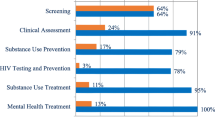Abstract
Recent studies have confirmed a high prevalence of youth with diagnosable mental health disorders within the juvenile justice system, as well as the vulnerability of youth in the mental health system who enter the juvenile justice system. This high prevalence of dual system involvement has spawned challenges of collaboration between the mental health and juvenile justice systems to provide needed services to youth and their families. Seventy-two in-depth interviews were conducted with 18 youth and their parents/guardians, mental health professionals from five different community mental health centers, and juvenile justice professionals in urban and rural communities in a Midwest state in the United States. Professionals, youth and parents identified several important factors that facilitated collaboration, as well as a myriad of barriers that needed to be overcome. Findings suggest ways to improve partnerships between the two systems and the development of supportive policies and procedures.
Similar content being viewed by others
References
Berg, B. L. (2004). Qualitative research methods for the social services. Boston: Allyn & Bacon.
Bolland, J., & Wilson, J. V. (1994). Three faces of integrative coordination: A model of interorganizational relations in a community. Health Services Research, 29(3), 341.
Erickson, E., & Stull, D. (1998). Doing team ethnography: Warnings and advice. Thousand Oaks: Sage.
Evens, C. C., & Vander Stoep, A. (1997). Risk factors for juvenile justice system referral among children in a public mental health system. The Journal of Mental Health Administration, 24(4), 443–455.
Foster, E. M., Qaseem, A., & Connor, T. (2004). Can better mental health services reduce the risk of juvenile justice system involvement? American Journal of Public Heath, 94(5), 859–865.
Kapp, S. (2000). Pathways to prison: Life histories of child welfare and juvenile justice system consumers. Journal of Sociology and Social Welfare, XXVII(3), 63–74.
Kapp, S. A., Robbins, M. L., & Choi, J. J. (2008). A partnership model study between juvenile justice and community mental health: Findings-collaboration. Lawrence: University of Kansas, School of Social Welfare.
Koppelman, J. (2005). Mental health and juvenile justice: moving toward more effective systems of care. Washington, DC: National Health Policy Forum.
MacQueen, K. M., McLellan, E., Kay, K., & Milstein, B. (1998). Codebook development for team-based qualitative analysis. Cultural Anthropology Methods, 10(2), 31–36.
Miles, M. B., & Huberman, A. M. (1994). Qualitative data analysis (2nd ed.). Thousand Oaks: Sage.
Models for Change: evidence based practices (2012). Publications, evidence based practices. http://www.modelsforchange.net/about/Issues-for-change/Evidence-Based-Practices.html?tab=issues. Accessed 6 Sep 2012.
Models for Change: Pennsylvania workplan (2012). Publications, states, Pennsylvania. http://www.modelsforchange.net/publications/119. Accessed 6 Sep 2012.
Models for Change: systems reform in juvenile justice (2012). Publications, Mental health issues. http://www.modelsforchange.net/publications/listing.html?tags=Mental+health. Accessed 6 Sep 2012.
Muhr, T. (2004). ATLAS.ti (V 5.0). Berlin, Germany: ATLAS.ti scientific software development GmbH.
O’Brien, M. & Holmes, C. (2008). Improving health access in frontier and rural counties. Office of child welfare and children’s mental health. http://www.socwel.ku.edu/occ/viewproject.asp?ID=76. Accessed 7 Sep 2010.
Pullmann, M. D., Kerbs, J., Koroloff, N., Veach-White, E., Gaylor, R., & Sieler, D. (2006). Juvenile offenders with mental health needs: Reducing recidivism using wraparound. Crime & Delinquency, 52, 375–397.
Rivard, J., & Morrissey, J. (2003). Factors associated with interagency coordination in a child mental health service system demonstration. Administration and Policy in Mental Health, 30(5), 397–415.
Rogers, K. M., Zima, B., Powell, E., & Pumariega, A. (2001). Who is referred to mental health services in the juvenile justice system. Journal of Child and Family Studies, 10(4), 485–494.
Shufelt, J. L., & Cocozza, J. J. (2006). Youth with mental health disorders in the juvenile justice system: Results from a multi-state prevalence study. Delmar: The National Center for Mental Health and Juvenile Justice.
Shufelt, J. L., Cocozza, J. J., & Skowyra, K. R. (2010). Successfully collaborating with the juvenile justice system: benefits, challenges, and key strategies. Washington, DC: Technical Assistance Partnership for Child and Family Mental Health.
Sickmund, M. (2004). Juveniles in corrections. Juvenile offenders and victims national report series. Washington, DC: The Office of Juvenile Justice and Delinquency Prevention.
Skowyra, K. (2006). A blueprint for change: Improving the systems response to youth with mental health needs involved with the juvenile justice system. Focal point (corrections issue): Research, policy, and practice in children’s mental health, 20(2), 4–7.
Skowyra, K., & Cocozza, J. J. (2007). Blueprint for change: a comprehensive model for identification and treatment of youth with mental health needs in contact with the juvenile justice system. Washington, DC: The Office of Juvenile Justice and Delinquency Prevention.
Snyder, H. (2003). Juvenile arrests 2001. Washington, DC: The Office of Juvenile Justice and Delinquency Prevention.
Teplin, L. A., Abram, K. M., McClelland, G. M., Dulcan, M. K., & Mericle, A. A. (2002). Psychiatric disorders in youth in juvenile detention. Archives of General Psychiatry, 59(12), 1133–1143.
Teplin, L.A., Abram, K.M., McClelland, G.M., Mericle, A.A., Dulcan, M.K., & Washburn, J.J. (2006). Psychiatric disorders of youth in detention. Juvenile Justice Bulletin, 1–15.
Wasserman, G. A., Jensen, P. S., Ko, S. J., Cocozza, J., Trupin, E., Angold, A., et al. (2003). Mental health assessments in juvenile justice report on the consensus conference. Journal of the American Academy of Child and Adolescent Psychiatry, 42(7), 752–761.
Wasserman, G. A., Ko, S. J., & McReynolds, L. S. (2004). Assessing the mental health status of youth in juvenile justice settings (pp. 1–7). August: Juvenile Justice Bulletin.
Author information
Authors and Affiliations
Corresponding author
Rights and permissions
About this article
Cite this article
Kapp, S.A., Petr, C.G., Robbins, M.L. et al. Collaboration Between Community Mental Health and Juvenile Justice Systems: Barriers and Facilitators. Child Adolesc Soc Work J 30, 505–517 (2013). https://doi.org/10.1007/s10560-013-0300-x
Published:
Issue Date:
DOI: https://doi.org/10.1007/s10560-013-0300-x




